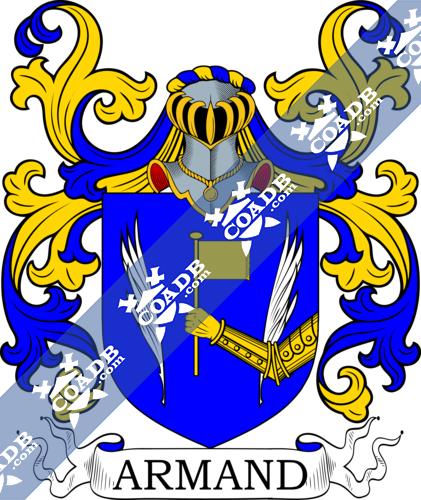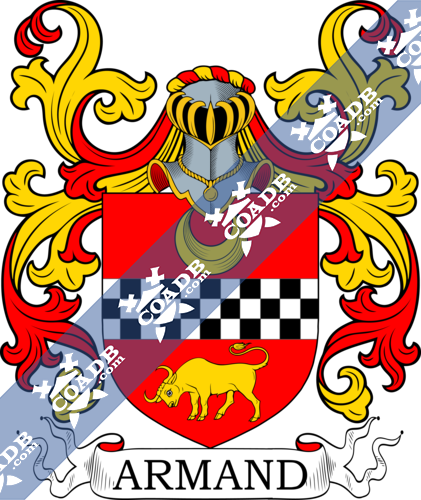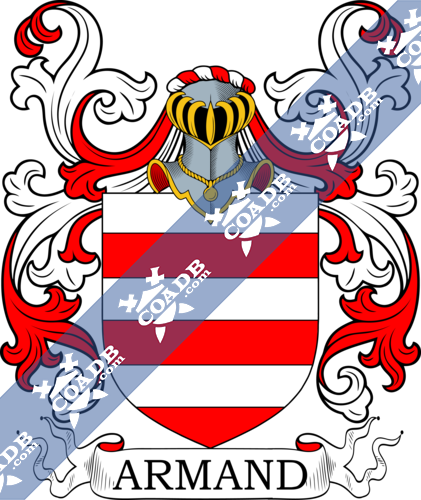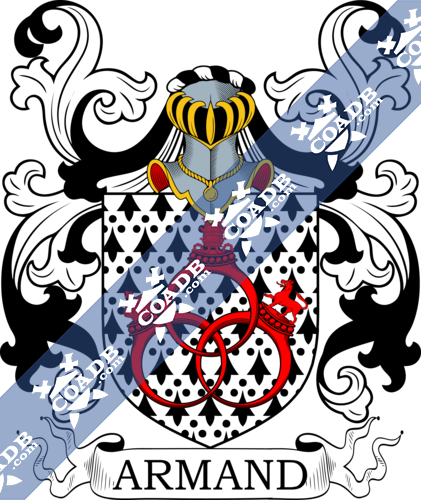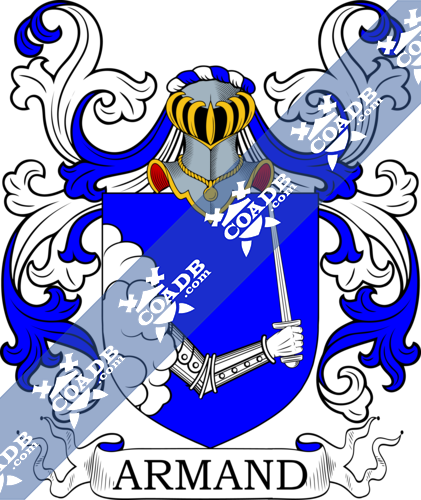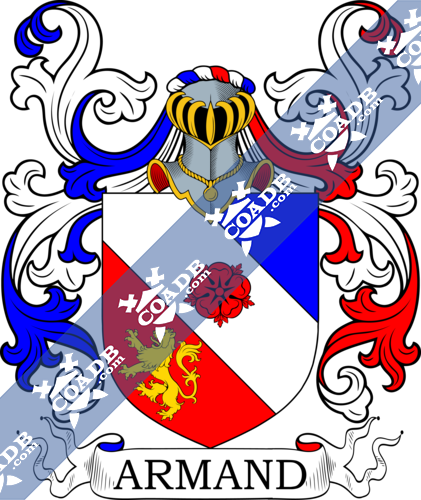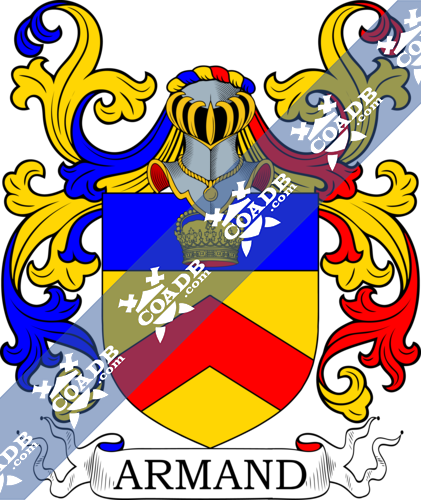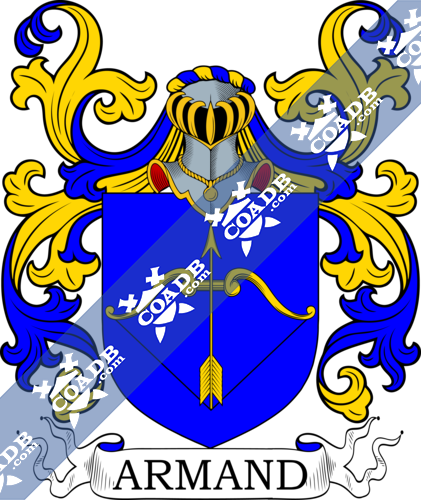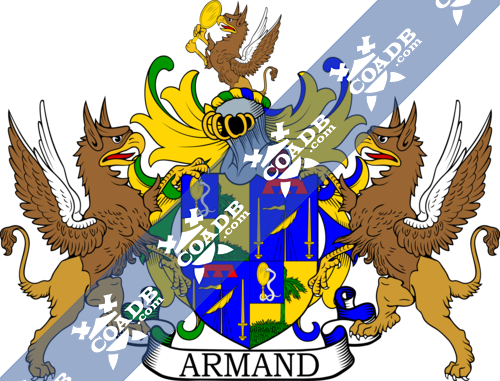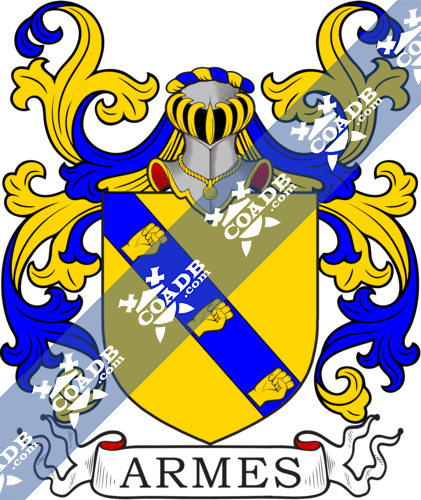Armand Family Crest, Coat of Arms and Name History
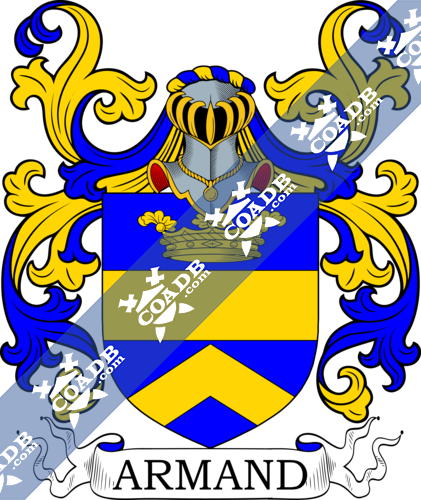
Armand Coat of Arms Gallery
Don’t know which Coat of Arms is yours?
We can do a genealogical research. Find out the exact history of your family!
Learn MoreArmand Origin:
England, France, German
Origins of Armand:
According to the early recordings of the spellings of the surname, this interesting and uncommon name is listed as Armand, Hammand, Hammond, Hammant, Hammon and many more. It is a popular Anglo-French surname, but one which can be of first Norse-Viking or next French and German sources of which it has three. The first origin is from the Norse-Viking particular name Hamundr, which means “High protection” and possibly brought into Britain in about the 7th century. The second is also Norse-Viking and of the same period, but from Amundr, meaning “offspring protection.” Over the centuries the two forms became complicated and combined. The third possible origin is probably of German origin from the particular name Haimo meaning Home but mentioned as Hammant by the Norman French attackers of England in 1066. It again became joined and fused with the two Norse spellings. Interesting examples of name ancestors are Richard Hamond of Sussex in the Premium Tax rolls of 1332, John Hammond who passed away in 1617 was physician to King James I of England VI of Scotland (1603 – 1625), while in France Jean Antoine Armand was a naming witness at La Chappelle-Graillouse, Ardeche, in September 1685.
Variations:
More common variations are: Armaand, Armandy, Armandi, Armando, Arjmand, Yarmand, Armanda, Armande, Armandt, Aramand.
England:
The origins of the surname Armand found in Provence where people held a family seat from early times. Someone say better before the success of Normans and the entrance of Duke William at Hastings 1066 A.D.
The very first recording spelling of the family was shown to be that of Walter Hamund, dated about 1242, in the “Free Rolls of Herefordshire.” It was during the time of King Henry III who was known to be the “The Frenchman,” dated 1216 – 1272. The origin of surnames during this period became a necessity with the introduction of personal taxation. It came to be known as Poll Tax in England. Surnames all over the country began to develop, with unique and shocking spelling variations of the original one.
United States of America:
Individuals with the surname Armand settled in the United States in three different centuries respectively in the 18th, 19th, and 20th. Some of the people with the name Armand who settled in the United States in the 18th century included Jacques Armand settled in Louisiana in 1757. Isabel Armand, who landed in America in the year 1760.
Some of the people with the surname Armand who settled in the United States in the 19th century included Mr. Armand liberal Roman with his wife and child, Elizabeth Armand, all arrived in New Orleans in 1822. Marie Armand landed in New York, NY in 1835. F Armand, who arrived in San Francisco, California in 1850. Mathiaus Armand settled in Philadelphia in 1856.
The following century saw many more Armand surnames arrive. Some of the people with the surname Armand who settled in the United States in the 20th century included Jules Armand, son of Raoul and Blanche Turcotte, of Saint-Sauveur, Québec, married Alphonsine Chabot, daughter of Emile and Elodie Gosselin in 1942
Here is the population distribution of the last name Armand: France 9,980; Haiti 5,373; Cameroon 3,965; Ivory Coast 3,068; United States 2,875; Iran 2,252; Uruguay 746; Argentina 463; Canada 430; Indonesia 405.
Notable People:
Abraham Armand was a Roman bishop.
David Armand (born 1977), is an English actor. He was born in the year 1977.
Émile Armand (1872-1962), was a French terrorist.
Frøydis Armand (born 1949), is a Norwegian actor. He was born in the year 1949.
Gesner Armand (born 1936), is a Haitian painter.
Gisken Armand (born 1962), is a Norwegian actress.
Inessa Armand (1874-1920), was a French communist.
Jean Armand de Lestocq (1692-1767), was a French explorer.
Joseph-François Armand (1820-1903), was a Canadian leader who played a major role in politics
Leanne Armand (born 1968), is an Australian marine scientist.
Louis Armand (1905–71), was a French Resistance representative.
Sylvain Armand (born 1980), is a French soccer player.
Blazons & Genealogy Notes
1) Marquis de Mizon – Provence Au lieu de les armes d’ de Blacon lisez D’azur à une fasce rehaussée d’or acc en chef d’une couronne ducale et en pointe d’un chevron le tout d’or. English: As per the arms of d’ dexter Blacon Azure a fess bordered (?) or surrounded by in chief a ducal crown and in base a chevron all or
2) Marquis de Blacons – Dauphiné, Provence – (M. ét.) Fascé d’argent et de gueules. English: Barry argent and gules.
3) Pays-Bas, France – Règl. d’arm. sur Lettres du 9 mars 1825, portant Conc. du titre de chevalier héréditaire, au chef de bataillon Jacques-Henri D’azur au lion d’argent tenant de sa patte dextre une épée aussi d’argent garnie d’or au chef d’or chargé de trois merlettes de sable. English: Azure a lion argent holding in its dexter paw an arming sword also argent hilt and pommell or a chief or charged with three female blackbirds sable.
4) Paris – (Comte romain, 26 nov. 1867; rec dudit titre, 4 juillet 1868) D’hermine à trois bagues de gueules enlacées en triangle les chatons garnis le premier de la tiare le deuxième de la couronne impériale et le troisième d’une louve Légende OB TUA (MERITA) Devise ET PATRIALE ET PATRI. English: Ermine three rings gules interlaced in a triangle the stones decorated 1st of the (Pope’s) tiara 2nd the imperial crown and 3rd a female wolf. (I am really not sure about this one!)
5) Marseille – Règl. d’arm. pour Joseph A. orfèvre à Marseille D’azur à un dextrochère armé mouvant d’une nuée au flanc dextre et tenant une épée le tout d’argent. English: Azure an armoured right arm coming from a cloud in the dexter flank and holding an arming sword all argent.
6) France Écartelé aux 1 et 4 d’or au palmier terrassé de sinople au franc-quartier d’azur ch d’un miroir d’or autour duquel se tortille et se mire un serpent d’argent aux 2 et 3 d’azur à un mât d’or accosté de deux épis du même et acc en chef d’un lambel de gueules Cimier un griffon issant tenant de ses pattes le miroir du 1 Supports deux griffons au naturel. English: Quarterly 1st & 4th or a palm tree on mount vert a quarter (like a canton but bigger) azure charged with a mirror or all around which a writhing serpent gazes at itself argent 2nd & 3rd azure a (ship’s) mast or alongside two arming swords of the same and surrounded by in chief a label gules Crest: a griffin issuant holding in its paws the mirror of the 1st Supporters: two griffins proper.
7) Dauphiné – (Arm. gén. de 1696) Tiercé en bande au 1 d’azur plein au 2 d’argent à une rose de gueules au 3 de gueules au lion d’or. English: Tierced in bend 1st azure (plain) 2nd argent a rose gules 3rd gules a lion or.
8) Dauphiné D’or au chevron de gueules au chef d’azur ch d’une couronne fermée d’or. English: Or a chevron gules a chief azure charged with a (closed) crown or (the crown with a velvet interior, like a Duke’s crown in English).
9) Auvergne D’azur à un arc d’or armé d’une flèche du même. English: Azure a bow or armed with an arrow of the same.
10) France D’azur au senestrochère d’or tenant une bannière déployée du second et acc de deux palmes d’argent. English: Azure an armoured sinister arm or holding a banner displayed of the 2nd and surrounded by two palm leaf argent.
11) Dauphiné – Armes concédées avec le titre de chevalier de l’Empire français, le 25 mars 1813 D’or à une fasce de gueules chargée du signe des Chevaliers-Légionnaires acc en chef d’un cor de chasse d’azur traversé en fasce d’une épée de gueules la pointe à dextre et en pointe d’un fort de gueules soutenu et terrassé du même issant d’une rivière de sinople. English: Or a fess gules charged with the sign of the Knight’s Legion (The Cross of the “Legion d’honneur” [a five-pointed maltese cross] without crown or ribbon, sometimes pommety, all argent and charged with a tierce gules) surrounded by in chief a hunting horn azure pierced by a sword fesswise gules the point to dexter and in base a fort (castle) gules on a mount of the same from which issues a river vert.
12) Dauphiné – (Paillot, La Vraie Science) D’azur au chevron d’argent acc de trois roses du mesme. English: Azure a chevron argent surrounded by three roses of the same.
13) de Châteauvieux – Bourgogne, Comtat-Venaissin, Genève De gueules à la fasce échiquetée d’argent et de sable de trois tires acc en chef d’un croissant d’or et en pointe d’un boeuf paissant du même. English: Gules a fess checky argent and sable of three rows surrounded by in chief a crescent or and in base an oxen grazing of the same.

